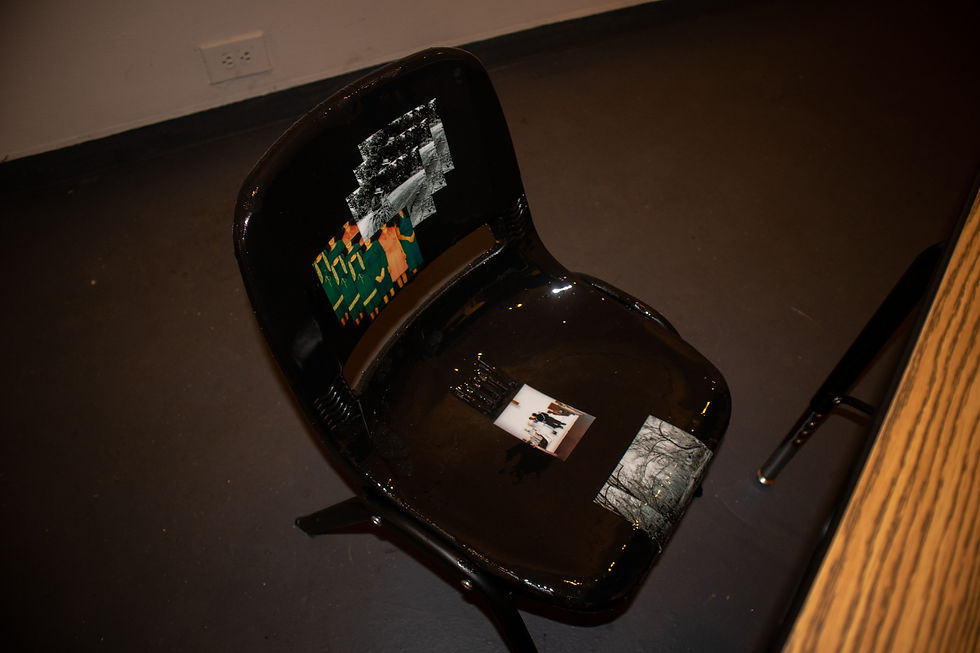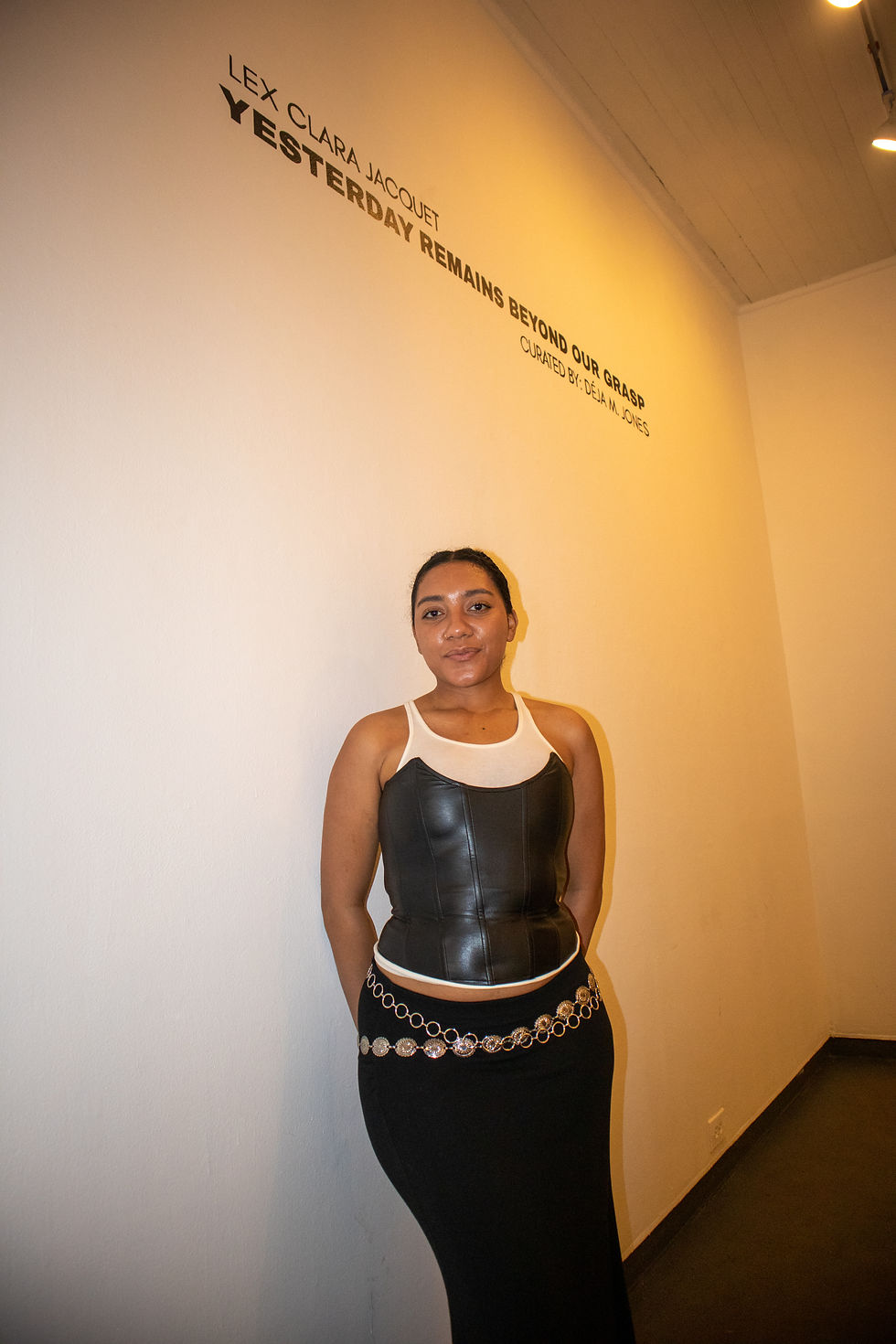lex clara jacquet: yesterday remains beyond our grasp at The Front, New Orleans
- TBD Magazine

- Aug 2
- 6 min read
Updated: Aug 2
BY LAURYN HINTON | August 2, 2025

At the top of the steps inside a home-turned-art gallery stands a familiar setting: a classroom. But it takes only a second more to notice something is not quite like the school room we all became so deeply acquainted with for a large portion of our lives.
On the West side of the St. Claude Avenue Bridge, inside The Front gallery, New Orleans-born, New York-based artist and curator lex clara jacquet reimagines the traditional classroom through gesture and inherited memory.
Speaking with jacquet on the closing day of her installation, yesterday remains beyond our grasp, she reflected with quiet satisfaction.
“This exhibition particularly marked a lot of beginnings. It was a lot of thinking through and pushing myself to face my fears. And so I'm happy to be taking it down because it's now inspired new thoughts.”

yesterday remains beyond our grasp asks the questions: What kinds of knowledge are granted legitimacy? What forms of care are policed? What knowledge arises when intimacy and remembrance are allowed in educational spaces?
jacquet asserts the classroom has long functioned as a site of indoctrination and contested knowledge, increasingly shaped by right-wing Christian ideology and the logics of racial capitalism.
In New Orleans today, most public schools are run by private, non-profit charter management organizations, like KIPP New Orleans and InspireNOLA, where funds allocated for childhood development are diverted to politically connected firms and CEO salaries.1
The show was exhibited within two miles of Dr. Martin Luther King High School. MLK is the only remaining public high school in the Lower Ninth Ward. What once was a symbol of rebirth for the neighborhood is now set to be shut down by the Orleans Parish School Board this school year.2

jacquet attended Cabrini High School, an all-girls Catholic school on Bayou St. John.
“Since I went to Cabrini, I think through what it meant for me to fit in and not really fit in at all with that school. None of my parents are from New Orleans, so having that lack of comfortability, then also a lack of familial knowledge coming in. It was an interesting space to explore what traces I had from both and how that shaped me,” said jacquet.
Through the making of this work, jacquet also explored the systems that shaped her schooling and continue to shape New Orleans today.
“It's like, how did we strip our schools? And then you think about why our education system is so bad down here in Louisiana, which is a multi-layered thing. But part of it is, the white people didn't want to keep putting their kids in the school system. And when the schools don't have money going in, obviously they go down because their funding becomes worse,” said jacquet.
The formation of numerous private schools further tells the story of class division and desegregation pushback that haunts New Orleans’ educational history.

For a brief time after the Civil War, Black organizers secured the desegregation of public schools in the 1867 Louisiana Constitution. White New Orleanians were strongly opposed to the integration of public schools, and white-owned newspapers encouraged parents to remove their children from desegregated schools. What started as only ten private schools in the city skyrocketed to more than 100 private institutions in just three years.3
Still, Louisiana has one of the highest rates of private school enrollment in the nation, with 13% of students aged K-12 enrolled in private institutions.4
Being native to New Orleans, for jacquet, this isn’t a distant or abstract issue, but a lived experience. The exhibition served as a space for critique and a chance to imagine something new.
The room comes alive in multidimensional ways. Chairs seem to call for touch. 2D paintings form a 3D triangular form, shaping the flow of the room.
The walls lack all description but the piece’s name, inviting the viewer to sit, look, and listen to what the classroom could never hold.

jacquet transforms banal objects commonly found in classrooms, including desks, boards, and chairs, through a visual language of touch and repetition. The three desks face three painted scenes with glimpses of new takes on traditional American pedagogy. On the three seats, she incorporates family photographs as personal poetic touches and signs of ancestral knowledge.
“The chairs are interesting because I'm obsessed with glitches and glitch theory, especially in Legacy Russell's work. In this work, I’m thinking about what the glitch means in real life, outside of online spaces. What is the glitch, or the miscommunication between the person someone is and the person they’re expected to be when they walk into a white, dominant Catholic school?”
For Black and queer children, the glitches that occur in the classroom turn supposedly “safe” school environments into hostile grounds for erasure and assimilation.
“That tension always bothers me, especially the lack of Black history we’re taught in the South, where it’s so important. And the lack of queer spaces. My high school was really anti-LGBTQ+. My sister was literally on the school’s watchlist.”
Having first-hand experience with the persecution at play in American schools, jacquet invites in care and remembrance to help us reimagine what learning can look like instead.

Remembrance is central in many Black and Latine diasporic cultures, especially in the face of forced forgetting.
What forms of knowing emerge when the classroom honors the knowledge we bring with us?
Familial histories are dense with relevant modalities of being, imagining, and persevering. But the act of remembering, especially within systems built to suppress it, can be layered, conflicted, and even painful.
Outside of this work, jacquet has been building a family archive with her sister through recipes and oral history. She describes working with her aunt, the family archivist, to collect images and stories, but she finds that memory isn’t always safe or accessible.
“When people are talking about [memory], it's always like they're telling me about their life, and they're thinking about it fondly, but, honestly, for my family, it's not good memories. It's a tread lightly type of conversation to ask them to go into their personal archive, just for me to retell it in a way. Maybe I'm just not around the same people, but that's something that I don't hear.”

In the pursuit of knowledge from those who preceded her, jacquet doesn’t offer complete resolutions in what care and remembrance can offer. Instead, she sits inside the contradictions and asks what questions remain.
"It's interesting because the curator in me always thinks about placement and setting. Especially when you think about what my work is, what it does, what it means, and in this space it's set at, The Front.”
Cultural organizations are often founded on promises of community transformation. But when they are shaped by dynamics of power, it becomes vital to examine whose needs are truly being met and who is left continuing to navigate the harshest realities.
At a moment when many are sitting with discomfort around the conditions of our world, it’s imperative to consider: what do we want on the other side, and who is shaping that future?
When institutions forget us, can we still remember ourselves, our histories, each other?
In a city where memory is often erased and where education is over monetized, yesterday remains beyond our grasp doesn’t pretend to create new truths. It reminds us that the most urgent ones are already here waiting to be remembered, honored, and used to build what’s next.
Notes
Ploof, S. (2025, May 11). Public money, private control: Inside New Orleans’ charter school overhaul. Big Easy Magazine. https://bigeasymagazine.com/2025/05/11/public-money-private-control-inside-new-orleans-charter-school-overhaul/
Fazio, M. (2024, December 9). Nola public schools to recommend closing historic 9th Ward High School and all-boys charter. NOLA.com. https://www.nola.com/news/education/new-orleans-mlk-high-school-arthur-school-board-close/article_af31c61a-b646-11ef-98de-cfce2908f0fa.html
McKenzie, Kristina D., "The desegregation of New Orleans public and Roman Catholic schools in New Orleans, 1950-1962" (2009). LSU Master's Theses. 266. https://repository.lsu.edu/gradschool_theses/266
National Center for Education Statistics. (2024). Private School Enrollment. Condition of Education. U.S. Department of Education, Institute of Education Sciences. Retrieved July 31, 2025, from https://nces.ed.gov/programs/coe/indicator/cgc.




Comments